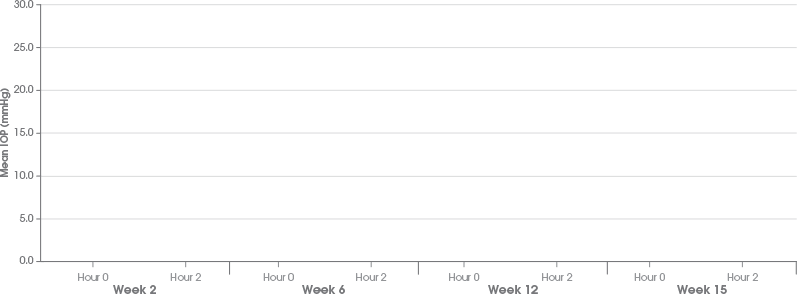
DURYSTA® 10 mcg (N=198)2

Timolol 0.5% BID (N=198)2
Baseline at Hour 0:
24.6 mmHg
Baseline at Hour 0:
24.6 mmHg



Up to 33% mean IOP reduction from baseline1
A first-in-class, biodegradable, intracameral implant for IOP control
24/7 drug delivery for several months1,2
Following administration, the intracameral implant is intended to settle within the inferior angle to deliver a sustained release of bimatoprost.1
Bimatoprost is believed to lower IOP in humans by increasing the outflow of aqueous humor through both the trabecular meshwork (conventional) and the uveoscleral routes (unconventional).1
Placement of the implant within the anterior chamber angle allows for close proximity to the tissues involved in both of these outflow pathways, where it delivers bimatoprost 24/7 for several months.1-3
After she was diagnosed with glaucoma, Monica started using eye drops to lower her IOP. She had trouble administering them at times and often forgot to use them. Later, her doctor suggested DURYSTA®.
IOP=intraocular pressure.
Actual DURYSTA® patient.

Not actual DURYSTA® patients.

Efficacy demonstrated in 2 clinical studies
Sustained IOP control, month after month1
Consistent Mean IOP Reduction Over Time1


DURYSTA® 10 mcg (N=198)2

Timolol 0.5% BID (N=198)2
Baseline at Hour 0:
24.6 mmHg
Baseline at Hour 0:
24.6 mmHg



Up to 33% mean IOP reduction from baseline1
Consistent Mean IOP Reduction Over Time1


DURYSTA® 10 mcg (N=176)2

Timolol 0.5% BID (N=176)2
Baseline at Hour 0:
24.3 mmHg
Baseline at Hour 0:
24.5 mmHg



Up to 32% mean IOP reduction from baseline1

Ocular
The most common ocular adverse reaction was conjunctival hyperemia, which occurred in 27% of patients.1
Other common ocular adverse reactions reported in 5-10% of patients were foreign body sensation, eye pain, photophobia, conjunctival hemorrhage, dry eye, eye irritation, IOP increased, corneal endothelial cell loss, vision blurred, and iritis.1
Ocular adverse reactions occurring in 1-5% of patients were anterior chamber cell, lacrimation increased, corneal edema, aqueous humor leakage, iris adhesions, ocular discomfort, corneal touch, iris hyperpigmentation, anterior chamber flare, anterior chamber inflammation, and macular edema.1

The most common nonocular adverse event was headache, which was observed in 5% of patients.1
Choose to order online with Allergan Direct through the buy-and-bill process—or acquire DURYSTA® through a specialty pharmacy. The videos below provide introductions to each of these options.
Allergan Direct offers a convenient experience with 24/7, on-demand flexibility. This solution allows you to place orders, pay invoices, and more.
Before ordering, you'll need to set up an Allergan Direct account by calling: 1-833-DURYSTA (1-833-387-9782)
Before you can begin taking advantage of this resource for ongoing DURYSTA® support, an Allergan EyeCue® account is required. Details are available at the Allergan EyeCue® site.
*Offer valid only for commercially-insured patients with plans covering DURYSTA®; patient out-of-pocket expense may vary. Offer not valid for patients receiving reimbursement from Medicare, Medicaid, or any other federal, state, or government-funded healthcare program. See Program Terms, Conditions, and Eligibility Criteria here or visit www.durystasavingsprogram.com
Physician Administration Guide
A complete reference for the DURYSTA® administration procedure

How to Order Flashcard
A handy reference to consult when ordering DURYSTA®

Patient Enrollment Form
Quickly enroll patients in Allergan EyeCue ® to begin taking advantage of the available resources

Billing and Coding Guide
A brief overview of billing and coding information for DURYSTA®
DURYSTA® (bimatoprost intracameral implant) is indicated for the reduction of intraocular pressure (IOP) in patients with open angle glaucoma (OAG) or ocular hypertension (OHT).
References: 1. DURYSTA® [Prescribing Information]. Irvine, CA: Allergan, Inc.; 2020. 2. Data on file, Allergan, 2020. 3. Standring S. Orbit and accessory visual apparatus. In: Gray’s Anatomy: The Anatomical Basis of Clinical Practice. 41st ed. Philadelphia, PA: Elsevier Limited; 2016:666-708. 4. DURYSTA® NDA FDA Approval Letter. March 4, 2020.